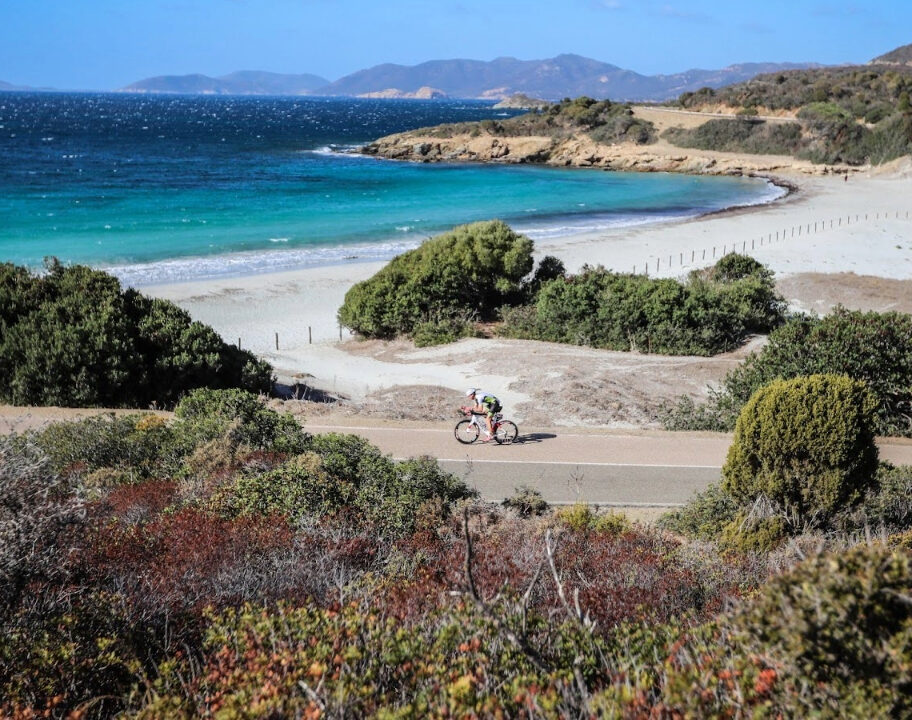If you’ve got a few pool-based triathlons under your belt and you’re working towards your first open water event, then a wetsuit might be at the top of your tri gear shopping list.
But when you’re new to open water swimming, the world of wetsuits and all the associated accessories can be a bit confusing. What type of wetsuit do you need? How should it fit? And what’s the best way to look after it to make sure it lasts you for plenty of triathlon seasons to come? In our beginners guide, we’ll talk you through everything you need to know about wetsuits. From why to wear one and how it should fit, to the triathlon wetsuit rules and how to look after your new suit.
What is a wetsuit for?
Before we dive into the specifics you might be wondering why you need a wetsuit for triathlon in the first place. From warmth and buoyancy, to triathlon race rules – there are several reasons to use a wetsuit during training and racing.
Does a wetsuit keep you warm?
One of the main reasons to wear a wetsuit for open water swimming and triathlon is for additional warmth in the water. The clue might be in the name – but a wetsuit isn’t designed to keep you dry. It’s actually designed to keep you warmer by trapping a thin layer of water between the neoprene and your skin. This water is heated up by your body temperature, and helps to keep you warmer for longer in cold water.
A wetsuit can help you to float better and swim faster
Wetsuits are typically made from a type of rubber called neoprene, which provides you with extra buoyancy when you’re in the water. Many triathletes, particularly those who’ve learned to swim later in life, suffer from ‘sinky legs’ in the water. When your legs sink, you create extra drag – making it harder work for you to make forward progress when you swim. A lot of triathletes find that once they put a wetsuit on, their body position is a lot better in the water because the wetsuit helps to keep their legs lifted. This can help you to swim faster.
Triathlon wetsuit rules
If you’re participating in a triathlon with an open water swim, then for the reasons we’ve outlined above – warmth, buoyancy and swim speed – it’s likely you’d want to wear a wetsuit. But it’s also worth knowing that there are specific rules around wetsuit use in triathlon.
The use of wetsuits in triathlon is governed by the various triathlon ruling bodies around the world. This gives event organisers and athletes clear guidance on the wetsuit rules. Usually whether you have to wear a wetsuit or not comes down to the water temperature and your age. The precise temperatures vary depending on the governing body of the country you’re racing in. But for example in the UK British Triathlon rules stipulate that wetsuits are mandatory at temperatures under 14 degrees Celsius for swims of 1500m or shorter (16 degrees C for longer swims). And banned above 22 degrees C for shorter swims, or 24.6 degrees C for longer race swims. Those temperatures vary slightly for athletes over the age of 60, and for PRO athletes.
In addition to water temperature for use of suits, there’s also some technical advice/rules that are worth bearing in mind:
- Wetsuits cannot exceed 5mm thickness anywhere. If the suit is made in two pieces, the combined thickness in the overlapping areas may not exceed the 5mm thickness limit
- Propulsion devices that create an advantage for the competitor, or a risk to others, are forbidden
- The most external part of the wetsuits will fit to the competitor’s body tightly while they are swimming
- A suit may cover any part of the body except the face, hands and feet
- There is no limitation regarding the length of the zipper
- Competitors may wear ‘shorty’ style wetsuits, but should be aware that they offer less protection against the cold
What type of wetsuit should I get? Triathlon swimming wetsuits vs surfing wetsuits
It’s important to make sure that you get a swimming-specific wetsuit for triathlon, rather than trying to swim in a surfing one. A surfing wetsuit’s primary purpose is to keep the wearer warm while they’re sitting or standing on a board. It’s not designed for the movements you perform when you’re swimming – which would make it really hard work to try and swim front crawl in one!
A swimming or triathlon wetsuit will be designed with thinner sections under the armpits and around the shoulders to give you freedom of movement. The necklines are generally lower compared to a surfing wetsuit, so that you can comfortably turn your head to breathe. A triathlon/swimming-specific suit will also have slightly thicker sections of neoprene around the hips to help lift your legs so you can have a better body position in the water.
Once you’ve finished the swim section of your race, you’ll also find that a triathlon wetsuit is far easier to take off in a hurry so that you can execute a speedy transition and get out on the bike as fast as possible.
What size wetsuit do I need? How a triathlon/swimming wetsuit should fit
Most major wetsuit brands these days have really comprehensive size guides which will help you to find the correct size for their specific wetsuit offering. If you’re between sizes, you might want to get hold of a couple of different sizes to try on to find the size that’s right for you.
It’s important to know that a wetsuit should be very close-fitting. You should need to take your time putting it on, and it’s not unusual to need someone to help you to zip it up. Once you’ve got your wetsuit on, you shouldn’t have any baggy or loose-fitting sections. But you should also be able to move your arms and shoulders freely, otherwise you’ll struggle to swim front crawl without feeling a lot of fatigue in your upper body.
“Fit is one of the most important things when it comes to choosing a wetsuit. If the body of the suit is too short, or too narrow, it’ll restrict your movement. But if it’s too big, the suit will flood with water which will make it feel heavy and you’ll experience more fatigue. The ideal wetsuit for you is the one that fits well around the body, while still offering flexibility around your shoulders.”
Angus Greenwood, CEO/Founder Yonda Wetsuits
If you’ve not worn a wetsuit before, the extremely close fit can take some getting used to – and it’s certainly not that comfortable to wear on dry land. But a well-fitting wetsuit will feel comfortable once you get in the water.
What to wear under a wetsuit
For general open water swimming and triathlon training, there’s no hard and fast rule about what you should wear under a wetsuit. Though for comfort – and modesty if you’ve got to get out of your wetsuit in full view of other swimmers – it’s advisable to wear something underneath! You can opt to wear your usual swimsuit, jammers or Speedos. Or you can wear a tri suit.
Come race day, the most efficient option is to wear a tri suit under your wetsuit. This means you won’t have to waste any time changing kit between the swim and the bike.
How to put a wetsuit on
Putting a wetsuit on can feel like a work out in its own right! It’s important to take your time, so you can get it on properly and avoid damaging your suit. Work methodically, using the pads of your fingertips – not your nails, to gradually pull the wetsuit up from the legs upwards one section of neoprene at a time.
Make sure there aren’t any wrinkled sections on the legs, and pull the crotch right the way up – otherwise the top section won’t sit comfortably. Once you’ve got the wetsuit on, spend some time pulling it up around your armpits and shoulders to make sure you’ve got as much freedom of movement as possible.
How to care for your wetsuit: cleaning, storage and minor repairs
So you’ve found your perfect wetsuit, you’ve taken it for a splash. Now what? There are a few important things to know when it comes to caring for your new suit to ensure it lasts you as long as possible.
How to wash a wetsuit
Let’s face it. Unless you’re lucky enough to be open water swimming somewhere with crystal clear water, your wetsuit can start to develop a certain ‘eau de lake water’ that you want to get rid of. The best thing to do is to just give your wetsuit a rinse in cold or lukewarm water in the shower or the bath after every swim. Rinse the outside and the inside, then turn it inside out and hang it up to dry using a wide clothes hanger or a specific wetsuit hanger.
Don’t put your wetsuit in the washing machine or the dryer, and avoid leaving it to dry in direct sunlight as the UV rays can damage the neoprene. You can also get special wetsuit shampoo if you’ve swum somewhere particularly mucky. But resist the temptation to use any harsh chemicals, as these will damage your suit.
How to store a wetsuit
Between open water swim sessions or triathlon races, the best way to store your wetsuit is to simply keep it on the hanger. Make sure you use a clothes hanger with wide shoulders to avoid the suit getting stretched out.
If you’re storing your suit for the winter and you don’t want to keep it hanging up – make sure you fold it just at the waist. Folding it up tightly can lead to creases and damage the suit long term. It’s also important that you make sure your suit is fully clean and dry before you store it – otherwise future you might be getting a mouldy surprise at the start of the next swim season.
What to do if you get any nicks or cuts in your wetsuit
It’s inevitable that no matter how careful you are, at some point you’ll accidentally get a nick or a cut in your wetsuit from your fingernails or when you’re taking it off with haste in transition at a race.
The good news is these minor bits of damage don’t necessarily mean your suit is ruined. Small nicks that are only superficial to the outer of the suit aren’t too much to worry about. And cuts that go through the neoprene but haven’t completely torn the inner fabric can easily be repaired at home with wetsuit glue (such as Black Witch).
For more extensive damage such as torn seams or cuts that won’t seal with a DIY solution, there are wetsuit repair specialists you can send your suit to. Some brands even offer their own repair service.











